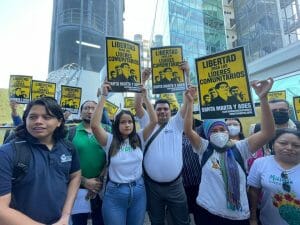NOVANEWS
The National Indigenous Organization of Colombia (ONIC) released findings Sept. 13 that 62.7% of Colombia’s indigenous population—a total of some 890,00 people—is at risk of extinction. Of the 102 indigenous communities in Colombia, 66 are found to be under grave threat, from forces such as large-scale mining development and the country’s ongoing armed conflict. The findings follow a ruling issued by Colombia’s Constitutional Court three days earlier that the government has not done enough to protect its indigenous population, after a 2004 decision by the same body ordered that additional measures be taken. The court held that efforts made over the previous decade to improve security for indigenous peoples have been ineffective and insufficient. The ruling found that indigenous communities are continuously victimized by armed groups forcing them off of their land, and endemic health problems caused by resource exploitation on their traditional territories. However, in contrast to ONIC, the court identified 36 indigenous groups at risk of extinciton.In Colombia, much of the indigenous population lives in autonomous territories set aside by the national Consitution. But these nominally autonomous communities have historically borne the brunt of the Colombia’s long-standing armed conflict, as well as its aggressive mining policy, which has led to mass deforestation and poisoned lands and waters with sulfur, cyanide, heavy metals and other toxins.In August, a report by independent broadcaster Noticias Uno affirmed fears about the health impacts of the Cerro Matoso open-pit nickel mine, run by PHP Billiton in Córdoba department, on the local Senú indigenous people. Televised footage documented a rash of degenerative maladies in local communities, with symptoms such as nail and hair loss, seeming to confirm residents’ fears that the mine—the fourth largest nickel operation on the planet—poses grave health risks to the Senú.Severe nickel contamination in local waters has been documented, and researchers at the University of the Andes in Bogotá are attempting to develop a “super-bacteria” to decontaminate effluent from the mine.
The Santos administration claims it has invested nearly $546 million in initiatives aimed at supporting Colombia’s indigenous population, but the Constitutional Court ruling asserts that government action has been slow and inefficient. ONIC has organized the first-ever Indigenous Copa America, an international soccer match featuring indigenous players from throughout the hemisphere, set to take place in Colombia next year, to draw attention to the destruction of traditional cultures and populations. (Colombia Reports, El Tiempo, Notimex, Sept. 13; Colombia Reports, Sept. 10; Colombia Reports, Aug. 6; CAOI, March 14)
Posted by Nysoulcontrolla aka Ali



